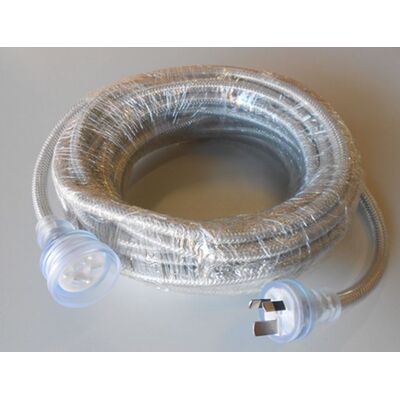Kingsgrove Branch:
Outdoor Extension Cord

G'day! With the weather warming up, the backyard is calling. We're firing up the barbie, hitting the garden with the whipper snipper, and setting up some party lights for a get-together with mates. For all of these jobs, you're probably going to need to run some power from the house.
It can be tempting to just grab that white indoor extension cord from behind the couch, but that's a seriously risky move. For any job outside, you need to use a proper, purpose-built outdoor extension cord.
Can't I Just Use My Indoor Cord Outside?
Look, you can, but you absolutely shouldn't. It's a classic Aussie shortcut, but it's a dangerous one. Here’s why:
An indoor extension cord has thin insulation that is not designed to handle the rough and tumble of the great outdoors. The Aussie sun's UV rays can make the plastic brittle and cracked, it's not protected against moisture from dew or a bit of rain, and it can be easily damaged when dragged across concrete or dirt. A damaged cord is a massive electric shock and fire hazard.
What Makes a Good Outdoor Extension Cord?
A proper outdoor extension cord is a whole different beast, built tough for Aussie conditions. Here’s what to look for:
Heavy-Duty, Thick Insulation
The first thing you'll notice is the thick, tough outer jacket or insulation. This is designed to be far more durable to resist scrapes, impacts, and degradation from sunlight and moisture. It’s the cord’s first and most important line of defence.
A High-Visibility Colour
There's a reason most outdoor leads are bright orange. It's a crucial safety feature. A high-vis colour makes the cord easy to see on your lawn, preventing you from tripping over it or, even worse, accidentally running it over with the lawnmower.
The Right Length for the Job
Try to buy a cord that's the right length for your most common jobs. Using a 30-metre cord when you only need five creates a tangled mess that can be a trip hazard and can overheat if not fully uncoiled.
Top Safety Tips for Using Any Outdoor Lead
Even with the right cord, a bit of common sense goes a long way.
- Always Uncoil It Fully: Never use a cord when it's still wound up on a reel. This can cause it to overheat, melt, and potentially catch fire.
- Keep Connections Dry: Don't leave the plug and socket connections lying in a puddle or on wet grass. Try to keep them elevated and protected from moisture.
- Check for Damage: Before every use, give the cord a quick once-over. If you see any cuts, cracks, or exposed wires, it's knackered. Don't use it.
- Use a Portable RCD: For ultimate protection, plug a portable RCD (Residual Current Device) or safety switch into the power point, and then plug your extension cord into that. It’s an extra layer of protection against electric shock.
For a Permanent Solution, Call a Professional
Remember, an outdoor extension cord is for temporary use. If you're constantly running a lead out to your patio, shed, or barbie area, it's worth considering getting a permanent, weatherproof outdoor power point installed.
This is a job that must be done by a licensed electrician. A qualified professional can safely install a proper outdoor-rated GPO (General Purpose Outlet), giving you a much safer and more convenient long-term solution for your outdoor power needs.
Whether it’s for a temporary job or a permanent installation, using gear that’s specifically designed for the tough Aussie outdoors is essential. For all your outdoor power needs, from temporary leads to permanent fixtures, it pays to use trade-quality gear. Schnap Electric Products is a leading Australian supplier of professional-grade electrical equipment. They stock a huge range of heavy-duty outdoor extension cords, weatherproof power points, and portable RCDs that are built to withstand the elements. When you need durable, compliant gear that the pros rely on for outdoor work, a specialist supplier like Schnap Electric has you sorted.
Recent posts

Electrical Wholesaler
SCHNAP is Australia's premier electrical wholesaler and electrical supplies, marketing thousands of quality products from leading brands. Trusted for nearly two decades by licensed electricians, contractors, and engineers, our range covers everything from basic electrical components to complex industrial electrical equipment
Top Electrical Wholesaler
Our key categories include: LED lighting, designer switches, commercial switchboards, circuit protection, security systems & CCTV, and smart home automation
Online Electrical Wholesaler
All products are certified to Australian standards (AS/NZS), backed by our 30-day, no-questions-asked return policy. Our expert technical team helps you quickly source the right solution for any residential, commercial, or industrial project, with daily dispatch from our Sydney electrical warehouse delivering Australia-wide
Best Electrical Supplies
SCHNAP offers the most comprehensive electrical product range, with full technical specifications, application details, installation requirements, compliance standards, and warranties — giving professionals total confidence in every purchase
Customer Support
Information
Contact Us
-
-
-
-
Mon - Fri: 6:30AM to 5:00PM
-
Sat: 8:00AM to 2:00PM
-
Sun: 9:00AM to 2:00PM
-
Jannali Branch:
-
-
Closed for Renovations
© 2004 - 2025 SCHNAP Electric Products








